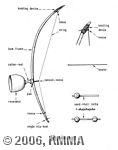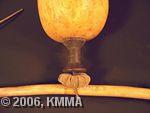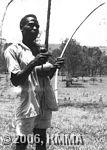





Other names: egubure, umunahi.
The egobore is a musical bow with one string and an attached sound box or resonator. The bow is a flexible decorticated branch measuring 120 to 140 cm in length, the ends of which are made slightly thinner. A string stretches from one end of the bow to the other and is attached with one single knot at one end and with several knots at the other. The string is usually made of plant fibre, but nowadays nylon is increasingly common. A loop positioned just off centre and attached to the bow pulls the string in towards the bow, thus dividing the string in two unequal halves and creating two different notes. The musical bow can then be tuned simply by moving the loop slightly. The loop has another function, however, as it runs through a small hole in the resonator and is attached inside the resonator with a small block that sits crossways across the hole. The gourd is thus attached to the bow and is in direct contact with the gourd resonator, which helps strengthen the sound. Part of the gourd is cut away, which creates an open resonator. And although the gourd resonator is then in contact with the string, the bow does not directly touch the resonator because a small cushion of soft material (grass or cotton) or an empty bobbin is inserted between the two. Experienced players also hold down the string with the second segment of the middle finger of the left hand to create an additional note. The string is struck with a flexible stick (dried hard grass) and springs back quickly when it touches the string; this creates a staccato effect.
The egobore is held vertically by the player with the opening of the gourd against the body. Other sounds are produced by pressing the gourd against the body or holding it away from the body as the instrument is played.
The musician playing the egobore also holds an akajebajebe rattle in the same hand together with the stick with which the string is struck, the rattle thus adding to the sounds that are played. Playing methods can vary greatly depending on the area: sometimes two rattles are used and sometimes additional rhythmic patterns are beaten on the gourd.
The egobore is known by the Nyambo, Hutu, Iru, Kooki and the Kiga, but is not a local traditional instrument originally. It comes from Tanzania and was introduced in Ankole via Rwanda.
The instrument is reserved for the men, who play it solo in accompaniment to their songs for relaxation.
for more information see also: VAN THIEL, Paul, "Multi-Tribal Music of Ankole. An ethnomusicological study including a glossary of musical terms." Edited by the Royal Museum for Central Africa, Annales, Sciences Humaines, nr 91, 1977, 234 pp.
© KMMA/Paul VAN THIEL